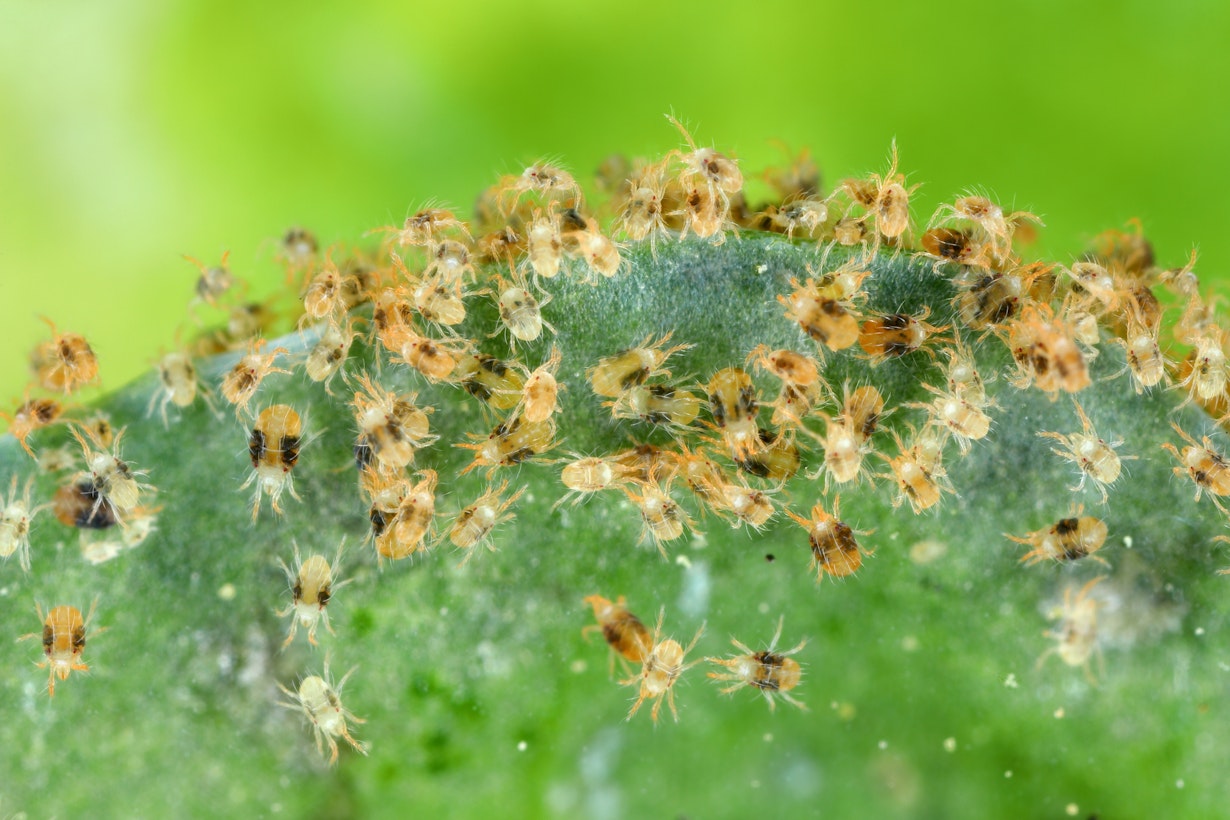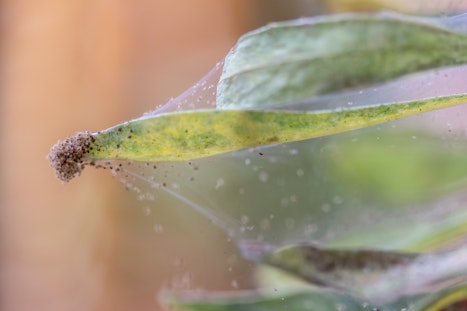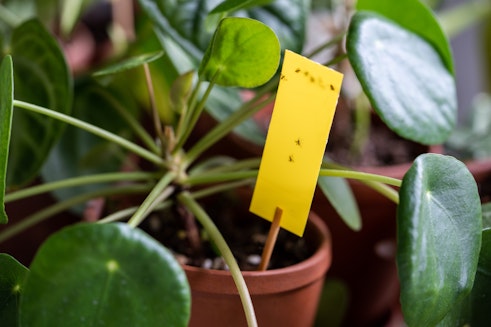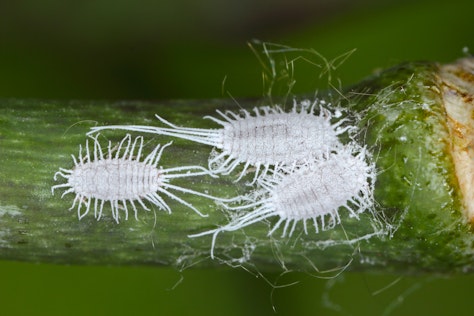
- Home
- Spider Mites - What are they and how do I get rid of them?

I presume you’ve stumbled across this blog as you have encountered a gross little civilization, populating the leaves of your plants. The majority of common indoor plant pests are big enough to spot peripherally, but the truth of spider mites is that alone, they are tiny. So tiny that to see them you have to squint and really get down. That is when you see it… An entire community of little pesky bugs, building little pesky webs across the surface of your favourite plants. Do not fret! Below is a complete guide to the spider mite, and how to ensure its swift exit from your plant collection!
First of all, it is important to note that the presence of pests says little to nothing about their keeper. Bringing plants into a house is like opening up a new, little ecosystem in your home. In the wild, these ecosystems contain all manner of beasts that keep each other in check and maintain a perfect balance, so that everything can thrive the way evolution intended. Unfortunately, in a home, the aspects of your ecosystem that are missing can be those which keep things like pests from getting out of control. As a result, we as plant-keepers must intervene. This is true for plant keeping at any level: from an orchid in the kitchen window, to an elaborate botanical garden greenhouse.
What is a Spider Mite?
Spider mites are a group of mite in the Tetranichydae family, most commonly Tetranychus urticae. While they are not spiders, they get their name from the layer of webbing they produce in order to protect themselves from predators. They are a communal species that often live in groups, using large amounts of webbing to protect the entire group. They are considered pests as they eat plant leaves. Spider mites can reproduce very quickly, producing as many as 20 eggs in a day. They have a life cycle of 3-4 weeks and can travel by ballooning, which is using their webbing to catch the wind and move on to a new spot. For these reasons, spider mite infestations can very easily get out of control, and are usually quick to gain resistance to chemical pesticides.
How do I know if I have Spider Mites?
The symptoms to look out for are as follows:
- Look for webbing: Spider mites will produce a very fine, light webbing, usually on the underside of the leaf. This webbing will look like lots of tiny threads, quite densely packed much like a spider’s web.
- Look for bugs: Underneath this webbing, a keen eye might spot tiny white bugs moving around, or sitting still and feeding. Often a spider mite problem will not be limited to one or two individuals, but a colony of small bugs in one place.
- Look for poorly plants: Sometimes, having plants with stunted growth, premature leaf-drop or misshapen leaves can be a sign of spider mites.
- Tiny yellow spots: Spider mite bites leave behind tiny yellow spots, that eventually convalesce and conjoin with others leaving larger patches of black & yellow damage. This type of damage is exclusive to tiny plant-predators like spider mites.
How do I get rid of Spider Mites?
There are several solutions to remove spider mites, depending on the severity of the infestation.
- Wipe: Similarly, wiping the stems, petioles and leaves of the infested plant with a wet cloth can physically remove spider mites. It is recommended to do this with dish soap or isopropyl alcohol, and needs to be done thoroughly.
- Prune: Sometimes, the infestation can be present only on one section of a plant, if possible, the removal of this section can eliminate the infestation entirely. Otherwise, the removal of any affected leaves can also stop the infestation. This is a good method for stronger plants that may only be affected on their soft, new growth.
- Dispose: For severe infestations that cannot be controlled, disposing of the affected plant can be the only solution. This ensures that the infestation cannot spread to other, nearby plants.
- Alcohol: A combination of 70% rubbing alcohol and water, applied to the body directly, dissolves the exoskeleton and ensures that the spider mite succumbs to the elements and dies. This is true also for their eggs, and should be reapplied every few days until the infestation is gone.
- Insecticidal soap: Mixing a concentration of Insecticidal soap and water, and applying it to all parts of the plant with a spray bottle is a good method to ensure that the whole plant is treated.
- Repotting: For root infestations, changing the soil and washing the roots with insecticidal soap can be a good solution to ensure that spider mites are not hiding in the soil.
- Horticultural oil: Applying neem oil can coat spider mites and their eggs and suffocate them. The oil can be mixed with water and sprayed directly onto the plant, or poured into the soil for root infestations. These processes should be repeated every few days until the infestation goes away.
- Natural predators: Introducing natural predators can be an effective and long lasting way to control spider mite infestations. Predators can be found easily online and are best for greenhouse or outdoor environments. But for indoor environments, you can use the ‘’Spider Mite Killer’, Phytoseiulus persimilis’, or Amblyseius californicus for preventative applications.
The best way to ensure complete control over a spider mite infestation is to use a combination of the above techniques, and to regularly check all plants, and repeat processes until there has been no sign of pests for at least a week.
How can I prevent them in the future?
Spider mites are one of the less common plant pests, and are actually quite a lot more selective about what kind of plant they go for! Preventative measures are the easiest way to combat pests, as it means you do not have to risk the loss of plants. There are several ways you can ensure that spider mites stay away from your plants:
- Isolate infested plants: If an infestation is found, isolate the affected plant to ensure the infestation doesn’t spread to others.
- Check new plants: When purchasing a new plant, check it thoroughly for pests before bringing it home. Most spider mite infestations come from outside the home, and many are brought in on plants. Some people suggest isolating all new plants for several weeks, just to be sure there is no risk of infestation.
- Keep plants healthy: Your plants are actually pretty good at fending off bugs by themselves. If they are in any way compromised, then their immune system will be less able to assist them during an infestation. So, avoid over and under watering, root binding and make sure they have adequate light!
- Check vulnerable plants regularly: The sooner an infestation is tackled, the easier it will be! Spider mites normally aim for more delicate plants with softer leaves, so it is unlikely you will ever have to contend with them on cacti or succulents, but rather daintier plants, especially herbaceous plants. (Calathea, Maranta, Fittonia, Hypostes, Schefflera, Hibiscus, young palms, young Dracaena etc.)
- Check tools & sundries: Spider mites & their eggs can survive dormantly for long periods on tools, and can be transferred unknowingly to plants through use. When using tools such as pruning scissors or trowels, ensure to wash them afterwards to ensure there are no unwanted hitch-hikers. When repotting plants, it is always a good idea to wash nursery pots or ceramics before or after use.
Remember that prevention is always the best solution, and can ensure you never have to deal with spider mites in the future. However, if they do find their way onto your plants, don’t panic. Return to this guide at any time, try any of the above methods, and the spider mites will regret the day they picked your plants to bother!
Jonathan Davies
Jonny has worked at Root since May 2023. His love for plants was inherited initially from his grandparents and parents, but really took off once he moved into his own place, where he started picking up small plants and was fascinated by watching how they grow and change over time. Jonny has a degree in Archaeology and Classics from the University of Sheffield, and a masters in Egyptology from Swansea University, where he primarily focused on garden culture in the ancient world, which he has managed to extend to a PhD thesis in the University of Liverpool, where he has been able to combine his love for plants with his love for ancient language and culture. Jonny loves being in the natural spaces around North Wales and Cheshire where he used to go growing up, and often spends hours examining the plants and trees, and kicking up the leaf litter searching for mushrooms and insects. He is fascinated most by plant biology, taxonomy and learning about ecosystems and interactions between plants and their environmental counterparts, and enjoys tending to his varied array of houseplants, and ongoing ‘plant projects’, such as growing plants from seeds and creating living epiphyte displays. Aside from his green thumb, his other interests include: art, reading, listening to and playing music in the company of his cats, Spooky and Boo.
More by Jonathan DaviesRelated Articles
View all articles



